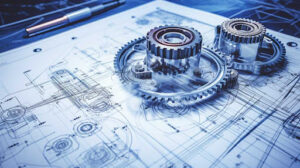Design and engineering practice involves the application of principles, techniques, and processes to create functional and innovative products or systems. This multidisciplinary field blends creativity with technical knowledge, addressing challenges in both design aesthetics and functionality. Professionals in this field work across various industries, ensuring the development of products that meet both user needs and safety standards.
In the context of product development, design and engineering practice ensures the integration of design thinking with engineering problem-solving. It includes stages such as conceptualization, prototyping, testing, and refinement, ensuring products are both practical and efficient. As technology advances, design and engineering practice continually adapts to incorporate new materials, tools, and methodologies.
What are the key principles of Design and engineering ?
User-Centered Design
Focus on understanding the needs, preferences, and limitations of the end-user to create products that are practical, accessible, and intuitive.
Functionality
Ensuring that the design serves its intended purpose efficiently, without unnecessary complexity or ambiguity.
Aesthetic Appeal
Creating visually pleasing products that are not only functional but also attractive to the user, improving both usability and satisfaction.
Sustainability
Incorporating environmental considerations into the design process by using materials, processes, and energy-efficient techniques that minimize negative ecological impact.
Safety and Reliability
Prioritizing user safety by adhering to relevant standards and regulations, and designing products that perform reliably over time.
Innovation
Encouraging creative problem-solving and embracing new technologies, materials, or approaches to advance the design and engineering processes.
Iterative Development
Using an ongoing process of prototyping, testing, and refining to progressively improve designs before finalizing them.
Cost Efficiency
Balancing the quality and functionality of a product while ensuring that it is produced at a reasonable cost without sacrificing essential features.
Collaboration
Involving cross-functional teams, including designers, engineers, marketers, and manufacturers, to integrate different perspectives into the design process.
Scalability
Designing products and systems that can be adapted or expanded as demands or circumstances change, ensuring longevity and adaptability.
Materials Selection
Choosing materials based on their suitability for the intended function, cost, durability, and environmental impact.
Simplicity
Striving for simplicity in design to reduce complexity and ensure that the product is easy to use and maintain.
Ergonomics
Designing products that fit the physical and cognitive needs of the user, ensuring comfort, ease of use, and minimizing physical strain.
Compliance with Standards
Ensuring that the design adheres to industry regulations, safety guidelines, and quality standards to ensure it meets legal and ethical requirements.
Documentation and Communication
Thoroughly documenting design processes, decisions, and specifications to facilitate collaboration, future development, and product maintenance.
How does design and engineering practice influence product development?
Design and engineerings are crucial in shaping how products are conceived, developed, and brought to market. They ensure that products are functional, reliable, and meet user expectations by integrating user needs, technological advancements, and feasibility studies into the development process. Effective practices lead to innovations, streamline production processes, and result in products that are both market-ready and efficient.
These practices also help in optimizing cost, quality, and performance, ensuring that products are not only functional but also sustainable and safe for users. By involving cross-disciplinary teams throughout the process, product development is enriched with diverse expertise, which ultimately enhances product success. Well-implemented Design and engineering s contribute to creating products that are competitive in the marketplace while fulfilling consumer demand and compliance standards.
What are the latest trends in design and engineering practice?
The latest trends in design and engineering focus on incorporating sustainability and efficiency throughout the development process. With an increased emphasis on environmental responsibility, engineers and designers are prioritizing eco-friendly materials and energy-efficient production methods. Additionally, the integration of smart technologies, such as artificial intelligence and the Internet of Things (IoT), is becoming more prominent, allowing products to be more interactive and intelligent.
Another key trend is the rise of automation and digital tools in the design and engineering fields. Technologies such as 3D printing, virtual reality, and simulation software are transforming how prototypes are created and tested. These innovations help accelerate development timelines, reduce errors, and improve the accuracy of designs, allowing for faster and more cost-effective production processes.
How can one improve skills in Design and engineering ?
Improving skills in design and engineering requires a combination of formal education and hands-on experience. Enrolling in advanced courses or certifications related to design software, CAD tools, and engineering principles can help deepen knowledge. Additionally, attending workshops and industry conferences provides exposure to the latest trends and technologies, offering opportunities to learn from professionals in the field.
Practical experience plays a crucial role in honing skills, as real-world projects challenge individuals to apply theoretical concepts. Engaging in collaborative team environments and working on diverse projects can expose one to different design challenges. Constantly seeking feedback from peers and mentors, as well as refining problem-solving approaches, allows individuals to grow and develop their abilities in the field of design and engineering.
What are the challenges faced in design and engineering practice?
Design and engineering practice often face the challenge of balancing creativity with technical constraints. Designers and engineers must create solutions that are not only innovative but also feasible within budget, time, and resource limitations. This balancing act can lead to compromises that may affect the final product’s performance or aesthetics.
Another major challenge is the need to adapt to rapidly changing technologies and methodologies. Keeping up with new materials, tools, and software can be overwhelming, especially as industries evolve quickly. Additionally, the pressure to meet client expectations and ensure sustainability and safety standards can create added complexity in the decision-making process.
How do design and engineering practices ensure innovation in technology?
Design and engineering s play a critical role in fostering innovation by incorporating creativity into the development process. By combining technical expertise with user-centric design principles, engineers can develop solutions that address real-world problems in new ways. Innovation often arises from a collaborative approach, where diverse teams work together to brainstorm and test cutting-edge ideas.
These practices also ensure that innovation is sustainable by considering long-term impacts such as environmental concerns, scalability, and economic feasibility. Engineers use iterative design processes, including prototyping and testing, to refine ideas and bring new technologies to market. By continuously adapting to emerging trends and technologies, Design and engineering s push the boundaries of what is possible, leading to groundbreaking advancements.
Visit our website for moe details.
Conclusion
Numbers like this one hold various applications across different fields, including technology, data analysis, and problem-solving. Their mathematical properties can be leveraged to optimize processes, enhance accuracy, and identify patterns in complex systems. Understanding the role of such numbers helps experts make informed decisions and develop innovative solutions in modern computing and analytics.












